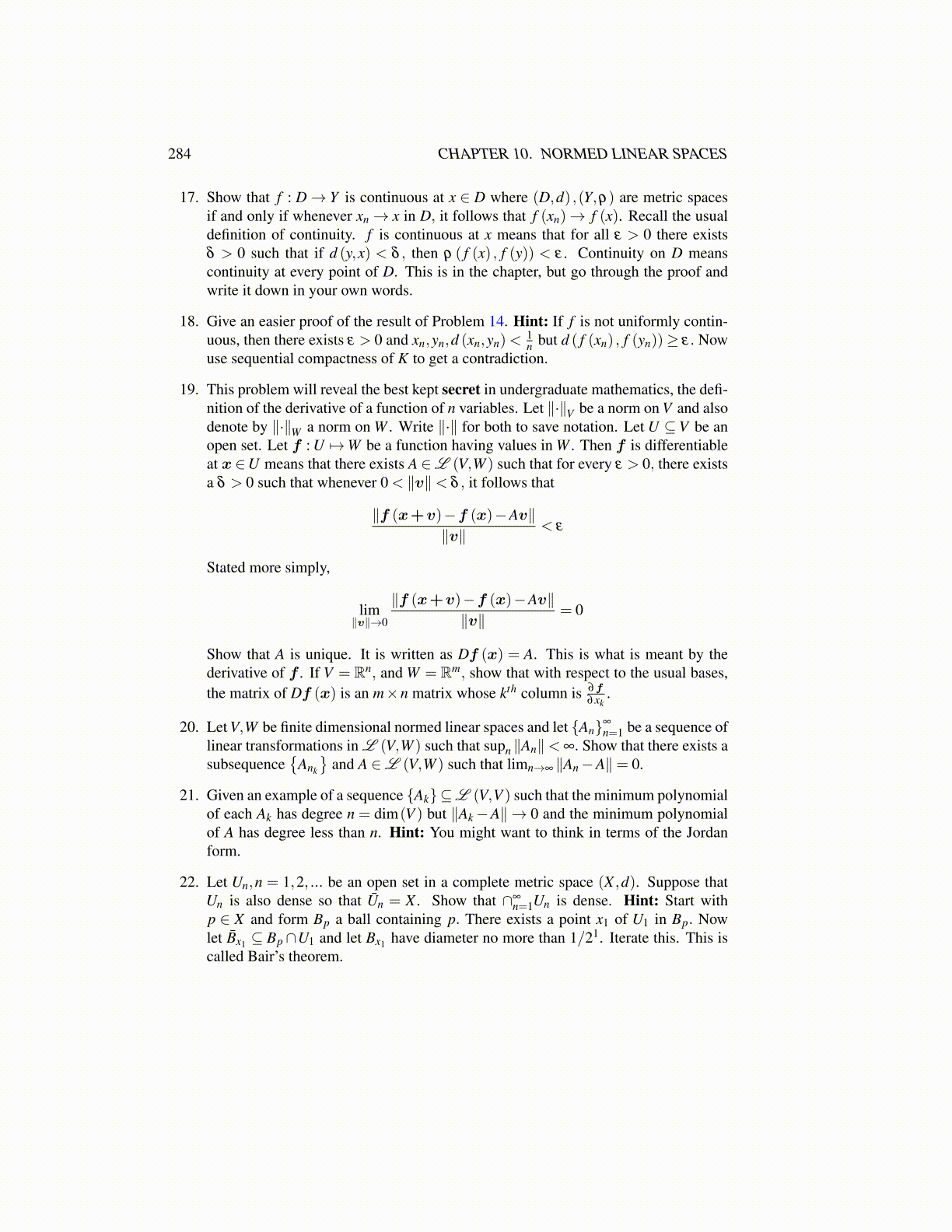
284 CHAPTER 10. NORMED LINEAR SPACES
17. Show that f : D→ Y is continuous at x ∈ D where (D,d) ,(Y,ρ) are metric spacesif and only if whenever xn→ x in D, it follows that f (xn)→ f (x). Recall the usualdefinition of continuity. f is continuous at x means that for all ε > 0 there existsδ > 0 such that if d (y,x) < δ , then ρ ( f (x) , f (y)) < ε . Continuity on D meanscontinuity at every point of D. This is in the chapter, but go through the proof andwrite it down in your own words.
18. Give an easier proof of the result of Problem 14. Hint: If f is not uniformly contin-uous, then there exists ε > 0 and xn,yn,d (xn,yn)<
1n but d ( f (xn) , f (yn))≥ ε. Now
use sequential compactness of K to get a contradiction.
19. This problem will reveal the best kept secret in undergraduate mathematics, the defi-nition of the derivative of a function of n variables. Let ∥·∥V be a norm on V and alsodenote by ∥·∥W a norm on W . Write ∥·∥ for both to save notation. Let U ⊆V be anopen set. Let f : U 7→W be a function having values in W . Then f is differentiableat x ∈U means that there exists A ∈L (V,W ) such that for every ε > 0, there existsa δ > 0 such that whenever 0 < ∥v∥< δ , it follows that
∥f (x+v)−f (x)−Av∥∥v∥
< ε
Stated more simply,
lim∥v∥→0
∥f (x+v)−f (x)−Av∥∥v∥
= 0
Show that A is unique. It is written as Df (x) = A. This is what is meant by thederivative of f . If V = Rn, and W = Rm, show that with respect to the usual bases,the matrix of Df (x) is an m×n matrix whose kth column is ∂f
∂xk.
20. Let V,W be finite dimensional normed linear spaces and let {An}∞
n=1 be a sequence oflinear transformations in L (V,W ) such that supn ∥An∥< ∞. Show that there exists asubsequence
{Ank
}and A ∈L (V,W ) such that limn→∞ ∥An−A∥= 0.
21. Given an example of a sequence {Ak}⊆L (V,V ) such that the minimum polynomialof each Ak has degree n = dim(V ) but ∥Ak−A∥ → 0 and the minimum polynomialof A has degree less than n. Hint: You might want to think in terms of the Jordanform.
22. Let Un,n = 1,2, ... be an open set in a complete metric space (X ,d). Suppose thatUn is also dense so that Ūn = X . Show that ∩∞
n=1Un is dense. Hint: Start withp ∈ X and form Bp a ball containing p. There exists a point x1 of U1 in Bp. Nowlet B̄x1 ⊆ Bp∩U1 and let Bx1 have diameter no more than 1/21. Iterate this. This iscalled Bair’s theorem.